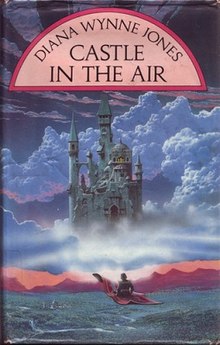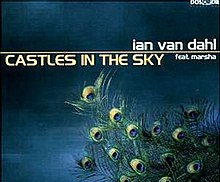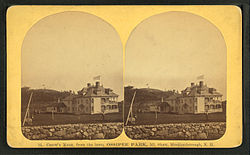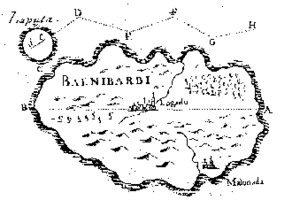Castle in the Sky (Japanese: 天空ã®åŸŽãƒ©ãƒ"ュタ, Hepburn: TenkÅ« no Shiro Rapyuta) (re-titled Laputa: Castle in the Sky for re-release in the United Kingdom and Australia) is a 1986 Japanese animated adventure film written and directed by Hayao Miyazaki and is also the first film produced and released by Studio Ghibli. The film was distributed by Toei Kabushiki Kaisha. Laputa: Castle in the Sky won the Animage Anime Grand Prix in 1986.
Plot
.jpg)
In the film's backstory, human civilizations built flying cities, which were later destroyed by an unspecified catastrophe, forcing the survivors to live on the ground while the sole exception Laputa remains in the sky, concealed within a powerful thunderstorm. In the story's opening, an airship carrying a girl, Sheeta, and her abductor, a secret agent working for the government named Muska, is attacked by the air-pirate Dola and her sons in search of Sheeta's crystal amulet. In the resulting struggle, Sheeta falls from the airship, slowed by the amulet mid-fall. Floating safely down to a small mining town, she is discovered by a boy named Pazu, who takes her into his home to recover. On waking, Sheeta is surprised to find that Pazu is building a small aeroplane, with the intention of finding the lost city of Laputa, as his father had taken a photograph of it while flying. She tells him that her family lived in a small valley to the north named Gondoa, and that she had lived alone once her grandmother had died, until being abducted by Muska and his agents. Later in the day they are pursued by Dola's pirates, and later by Muska's soldiers. Eventually, the two fall into an abandoned mine, where they encounter the local eccentric 'Uncle Pomme', who informs them that Sheeta's amulet is one of the 'volucite' crystals ('Aetherium' in the American release) formerly used to keep Laputa aloft.
Upon leaving the mines, Sheeta reveals her full name of 'Lusheeta Toel Ul Laputa'; whereupon they are captured by Muska, and when Pazu tries to defend Sheeta, he is knocked out in the process, and are taken to the fortress of Tedis; Pazu is imprisoned in the fortress' dark, cold and damp tower while Sheeta is imprisoned in a more lavish room. Later, Muska shows Sheeta a dormant Laputan robot and reveals his knowledge of her secret name, which he interprets as that of a Laputan royal line. Muska then threatens to have Pazu killed by the military if Sheeta refuses to cooperate. In order to prevent this from happening, Sheeta orders Pazu to leave for his own safety, but not before Muska offers him money as a bribe not to come back and to forget about finding the truth about Laputa. Distraught, Pazu returns to his own house, only to be dragged forcibly inside the house by Dola's sons and tied up. After being questioned and derided as a "scared little boy who runs away," Dola explains to Pazu that Sheeta was forced to tell him this in an effort to protect him. She also explains that once Muska has what he wants from her, he will most likely kill her. Upon hearing that airship Goliath will be taking off with Sheeta to find Laputa, Dola and her sons prepare to intercept and capture the crystal. Pazu asks Dola to join her pirates to save her. Dola refuses but, after a moment of thought, reluctantly accepts, cuts Pazu loose and immediately leaves for the fortress of Tedis. Sheeta, retained by Muska, recites an apotropaic verse and unexpectedly activates the amulet and the robot, who proceeds to destroy the fortress, while Pazu and Dola's pirates embark in winged 'flaptors' to rescue Sheeta themselves. Meanwhile the robot seizes Sheeta, but when struck by Muska's artillery, retaliates against the fortress, until Sheeta orders it to desist, losing her amulet in the process. The robot is then overcome by Goliath, and Pazu rescues Sheeta, while Muska obtains the amulet.
The pirates, accompanied by Pazu and Sheeta, return to their airship Tiger Moth, where Dola assigns Sheeta to the galley and Pazu to assist her engineer, and in which they pursue the direction identified by Sheeta's amulet as that of Laputa, while Muska follows in the same direction in the Goliath. Both airships arrive at Laputa on the following day, where the two children, separated from Dola's pirates, discover a city devoid of human life, but possessed of a park-like woodland with a gigantic "Eternal tree of life", maintained by a robot resembling that of the fortress. Muska's soldiers plunder the city's treasures, holding Dola's pirates captive, with the intention of having them lynched. The ancient city is revealed to be twofold; a crumbling, overgrown yet beautiful ruin of a castle above, and a perfectly preserved scientific marvel below, utilizing the ultimate evolution of the crystal levitation technology displayed by Sheeta's amulet, as well as holography, magnetic cohesion, pseudo-nuclear weaponry and a veritable army of the semi-sentient robots. Upon gaining entrance to the city's central sphere, Muska captures Sheeta and his agents open fire upon Pazu, receiving a scratch to his left cheek; whereupon Pazu frees Dola's pirates and pursues Muska.
In the center of Laputa, containing the immense 'volucite' crystal keeping the city aloft, Muska identifies himself as "Romuska Palo Ul Laputa", another royal line, and uses Sheeta's "key" crystal to access the advanced Laputian technology. He then massacres the soldiers, and destroys the Goliath. During the mayhem, Sheeta seizes her crystal amulet and flees, prompting Muska to pursue her. Encountering Pazu through a gap in a wall, Sheeta gives him her amulet, and is herself later cornered by Muska in Laputa's abandoned throne room. Arguing with Muska, Sheeta realizes and explains that the people of Laputa left the castle because it had no life. Muska refuses to believe her and shoots off her two braids, threatening to shoot her ears as well unless the crystal amulet is given to him. Pazu then enters and says he'll give the crystal amulet to Muska if Pazu can talk to Sheeta; Muska grants the two one minute to negotiate. Sheeta and Pazu then recite a "Spell of Destruction", blinding and killing Muska and destroying much of the city. Having survived the collapse, Pazu and Sheeta re-unite with Dola and her pirates (who have had the presence of mind to swipe some of the city's treasures before fleeing), and later part from them to fly to Gondoa as Pazu had promised, whereupon the ending credits show the remains of Laputa still aloft, with the guardian robot still tending the garden, maintained by the volucite crystal embedded in the roots of the central tree, in high orbit above the earth.
Cast
Soundtrack
.jpg)
All compositions by Joe Hisaishi.
- "The Girl Who Fell from the Sky" â€" 2:27
- "Morning in Slag Ravine" â€" 3:04
- "A Fun Brawl (Pursuit)" â€" 4:27
- "Memories of Gondoa" â€" 2:46
- "Discouraged Pazu" â€" 1:46
- "Robot Soldier (Resurrection/Rescue)" â€" 2:34
- "Carrying You" â€" 2:02 (Chorus: Suginami Children's Choir)
- "Sheeta's Decision" â€" 2:05
- "On the Tiger Moth" â€" 2:32
- "An Omen to Ruin" â€" 2:18
- "The Sea of Cloud Under the Moonlight" â€" 2:33
- "Laputa: Castle in the Sky" â€" 4:36
- "The Collapse of Laputa" â€" 2:00 (Chorus: Suginami Children's Choir)
- "Carrying You" â€" 4:07 (sung by Azumi Inoue)
Influences
The name 'Laputa' is derived from Jonathan Swift's novel Gulliver's Travels, wherein Swift's Laputa is also a flying island controlled by its citizens. Anthony Lioi feels that Miyazaki's Laputa: Castle in the Sky is similar to Swift's Laputa, where the technological superiority of the castle in the sky is used for political ends.
Laputa is credited by Colonel Muska with having informed Biblical and Hindu legends â€" thus tying the world of Laputa to our Earth (and to western European civilization) â€" as do the medieval castle architecture on the ground; the Gothic and half-timbered buildings in the village near the fort; the Welsh mining-town architecture, clothing, and ground vehicles of Pazu's homeland; and the Victorian ambiance of the pirate ship. The anime also makes references to the Hindu epic Ramayana, including "Indra's arrow", while the name Sheeta may be a reference to Sita, the female lead in the Ramayana.
Some of the architecture seen in the film was inspired by a Welsh mining town. Miyazaki first visited Wales in 1984 and witnessed the miners' strike firsthand. He returned to the country in 1986 to prepare for Laputa, which he said reflected his Welsh experience: "I was in Wales just after the miners' strike. I really admired the way the miners' unions fought to the very end for their jobs and communities, and I wanted to reflect the strength of those communities in my film." Miyazaki told The Guardian, "I admired those men, I admired the way they battled to save their way of life, just as the coal miners in Japan did. Many people of my generation see the miners as a symbol; a dying breed of fighting men. Now they are gone."
Distribution and reception

In the late 1980s, an English dubbed version, produced by Magnum Video Tape and Dubbing for international Japan Airlines flights at the request of Tokuma Shoten, was briefly screened in the United States by Streamline Pictures. It came out in theaters in 1995 and got released on VHS a year later in 1996. Carl Macek, the head of Streamline, was disappointed with this dub, deeming it "adequate, but clumsy". Following this, Tokuma allowed Streamline to dub their future acquisitions My Neighbor Totoro and Kiki's Delivery Service. The Streamline dub of Laputa: Castle in the Sky is currently available only on the Japanese DVD release along with the Streamline dub of My Neighbor Totoro.
The Disney-produced English dub was recorded in 1998 and planned for release on video in 1999, but Disney eventually decided to release it to theaters instead.
After Princess Mononoke (1997) did not fare as well in the US as Japan, Laputa's release date was pushed back yet again; on occasion the completed dub was screened at select children's festivals. The film was finally released on DVD and video in the US on August 16, 2005 alongside Kiki's Delivery Service and Spirited Away. As with Mononoke and Kiki, critical opinion was mixed about the new dub, but Cloris Leachman and Mark Hamill's performances as Dola and Muska drew praise. Laputa was the second-best selling DVD from Studio Ghibli distributed by Disney in the year of its release (after Spirited Away and ahead of Kiki's Delivery Service). Laputa was reissued on American home video in March 2010 as a tribute accompanying the home video release of Ponyo. The film was released on Blu-ray in North America on May 22, 2012, alongside Whisper of the Heart and The Secret World of Arrietty.
The film currently holds a 94% "Fresh" rating at Rotten Tomatoes. In an audience poll (with 80,402 voters) of 100 best animations of all time, conducted by Japan's Agency for Cultural Affairs in 2007, Castle in the Sky was the second highest-ranked animated film, and third highest-ranked animation overall on the list.
The film received a re-screening on May 22, 2011 in Aberystwyth as part of a charity fund for Japan. The print shown was the original theatrical Japanese print with English subtitles.
The most tweeted moment in the history of Twitter was during the airing of Castle in the Sky on August 2, 2013 when fans tweeted the word "balse" at the exact time that it played in the movie. There was a global peak of 143,199 tweets in one second.
Awards
- ÅŒfuji NoburÅ Award; Mainichi Film Award
- First Place; Pia Ten (Best Films of the Year)
- First Place; Japanese Movies; City Road
- First Place; Japanese Movies; Eiga Geijutsu (Movie Art)
- First Place; Japanese Films Best 10; Osaka Film Festival
- Eighth Place; Japanese Films; Kinema Junpo Best 10
- Second Place; Readers' Choice; Kinema Junpo Best 10
- Best Anime; 9th Anime Grand Prix
- Special Recommendation; The Central Committee for Children's Welfare
- Special Award (to Miyazaki & Takahata); Revival of Japanese Movies
- Best Design Award; Anime
Title

Although meaningless in Japanese, the name "Laputa" comes from Jonathan Swift's Gulliver's Travels. English language dubs of Laputa have been released under three different titles by three separate distributors, which is largely due to the similarity to the Spanish slang "la puta" (lit. "the whore"), which would be offensive to many.
In 2003, the film's title was shortened from Laputa: Castle in the Sky to Castle in the Sky in several countries, including the United States, Mexico, and Spain. In Spain the castle was named Lapuntu. This change was carried to a number of non-Spanish speaking countries, including Britain and France, under Disney's Buena Vista Home Entertainment label. Although "Laputa" was removed from the title, it appeared on the rear cover of the DVD, and was used throughout the film, without modification.
The film's full name was later restored in Britain, in February 2006, when Optimum Asia â€" a division of London-based Optimum Releasing â€" acquired the UK distribution rights to the Studio Ghibli collection.
Additionally, during the late 1980s and early 1990s, the original English dub (the older, non-Streamline dub, or the pre-Disney dub) was screened in the UK, as an art house film, under the alternative title Laputa: The Flying Island. It was shown at least twice on British television, but some scenes were cut.
Differences between versions

Although the plot and much of the script was left intact, Disney's English dub of Laputa: Castle in the Sky contains some changes. These differences do not appear in the original dub.
- A significant quantity of background chatter and one-liners were added (even more so than in Disney's dub of Kiki's Delivery Service), filling in moments of silence and increasing the frenetic effect of certain scenes.
- Composer Joe Hisaishi was commissioned to rework and extend his original synthesizer-composed 39-minute soundtrack into a 90-minute piece for symphony orchestra in an effort to make the film more accessible to US audiences who are accustomed to a more substantial musical accompaniment. Newer sound effects were included as well, presumably to bring the film up to theatrical standards.
- Pazu and Sheeta, as portrayed by James Van Der Beek and Anna Paquin, are made to sound several years older, placing them in their mid-teens, rather than their pre-teens (in the original Japanese version, Pazu and Sheeta's voice actors were women, who were much more capable of providing the voices for juveniles than men).
- Several modifications were made to dialogue spoken to/about Sheeta by members of the Dola gang, including a declaration of love by one of the pirates. In the original Japanese version, the dialogue presented Sheeta as a potential mother figure to the pirates, instead of a potential romantic interest.
- References to Robert Louis Stevenson's Treasure Island were removed (kept in the original dub), as was the reference to Jonathan Swift's Gulliver's Travels (removed in the original dub).
Although all these alterations were approved by Studio Ghibli and Miyazaki, there have been a number of critics who called them into question. On the other hand, Miyazaki himself is said to have approved of Hisaishi's reworking; his compliments were echoed by several reviewers. The 2010 DVD re-release (later ported to a 2012 U.S. Blu-ray release) omits most of these changes. The new score has been removed, having been replaced by Hisaishi's original synthesizer score, the sound effects are reverted to the original Japanese production, and a lot of the added dialogue has been eliminated, making the dub closer to the original Japanese. Additionally, the subtitles on the newer release are mostly dubtitles. (Oddly, however, the Japanese, Australia, and UK Blu-rays contain the newer score on the Disney dub track â€" minus the extra dialogue and newer sound effects â€" as well as literal, properly timed subtitles.)
See also

- Windaria (another anime film, premiering earlier in the summer of 1986, with a large tree central to the story)
- Nadia: The Secret of Blue Water (an anime that was based on a similar idea by Hayao Miyazaki)
- Atlantis: The Lost Empire
References

External links

- Official website
- Tenku No Shiro Rapyuta at the Big Cartoon DataBase
- Laputa: Castle in the Sky at the Internet Movie Database
- Castle in the Sky at AllMovie
- Castle in the Sky (anime) at Anime News Network's encyclopedia
- 天空ã®åŸŽãƒ©ãƒ"ュタ (TenkÅ« no Shiro Rapyuta) at the Japanese Movie Database (Japanese)
- Detailed Laputa information on Nausicaa.net

Posting Komentar